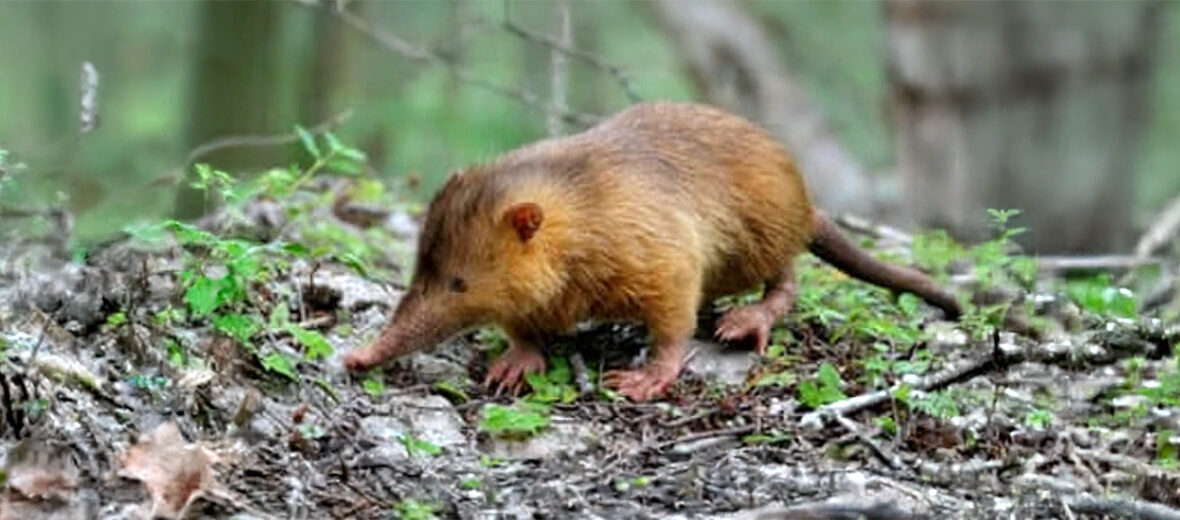
The Hispaniolan solenodon, aka agouta, is endemic to the Caribbean island of Hispaniola, in the Dominican Republic and Haiti. These rather unique animals are related to shrews and moles. They are also venomous. They face the threats of habitat loss and destruction at the hands of the logging industry; hunting; trapping; and invasive species, that result in predation and the potential for disease. However, they are abundant enough to be listed as Least Concern by the IUCN. They are also listed as Moderately Depleted and their population trend is unknown at this time.
First the Stats…
Scientific name: Solenodon paradoxus
Weight: Up to 1.75 lbs.
Length: Up to 19 inches, plus up to a 9.8 inch tail
Lifespan: Up to 11 years
Now on to the Facts!
1.) Solenodons are nocturnal (active at night).
2.) They spend a fair amount of their time in their burrows.
3.) These critters were first described by Johann Friedrich Brandt in 1833.
4.) The Hispaniolan solenodon and the rat-like Hispaniolan hutia dwell in the same habitats and are the only surviving mammals native to the island of Haiti.
5.) Solenodon means “grooved teeth”.
But wait, there’s more on the Hispaniolan solenodon!
6.) Their forelegs are quite a bit more developed than the hind legs, but all limbs have strong claws used for digging burrows.
7.) The 2nd lower incisor has a narrow tubular channel that’s almost completely enclosed, through which flows their venomous saliva that is secreted by the submaxillary gland.
Did you know…?
Injection of up to 0.55 mg of venom per gram of body mass has been proven to be fatal to mice in up to 6 minutes. While not fatal to humans, their venom can cause pain and swelling at the bite location.
8.) They have patches of skin that are rich in apocrine glands on the thighs. The secretions of these glands are utilized in communication between one another.
9.) There are 2 recognized subspecies: Solenodon paradoxus paradoxus (northern Dominican Republic) and Solenodon paradoxus woodi (far southern Dominican Republic & Haiti, Tiburon Peninsula)
10.) When they exit their burrows they run on the soles of their feet, engaging in an erratic, zigzag course.
But wait, there’s still more on the Hispaniolan solenodon!
11.) These critters feast on worms, snails, mice, and small reptiles; they might also feed on small amounts of fruit, grains, and leaf litter.
12.) Their vocalizations include sounds such as a loud defensive “chirp”, a soft “squeak” when encountering familiar individuals, an aggressive “squeal”, and a high-pitched “clic” when faced with a stranger.
Did you know…?
Typically only 2 of the offspring survive, because the female only has 2 teats, which are located towards the groin.
13.) They have also been documented making echolocation clicks at 9 – 31 kHz.
14.) Mating occurs about every 10+ days.
15.) Females undergo a gestation (pregnancy) period of up to 84 days that produces up to 3 pups.
But wait, there’s still a little more on the Hispaniolan solenodon!
16.) The young are born altricial (blind and hairless), and weighing up to just 1.9 ounces. They are carried around by the mother for the first 2 months of their life. The weaning period is not known at this time.
17.) Due to the lack of natural land predators, Hispaniolan solenodons failed to evolve defenses, and they are slow, clumsy runners.
Did you know…?
The solenodon is 1 of the last 2 surviving native insectivorous mammals found in the Caribbean, and 1 of the only 2 remaining endemic terrestrial mammal species of Hispaniola. They are also among the 4 species groups of venomous mammals, including the platypus, loris’, and some shrews.
18.) They are preyed on by 2 species of owls, and introduced dogs, cats, and Asian mongooses.
19.) In 2016, researchers at the University of Illinois and the University of Puerto Rico completely sequenced the mitochondrial genome of these solenodons. The study proved that solenodons diverged from all other living mammals about 78 million years ago.
20.) It has been speculated that these solenodons arrived in Haiti via a volcanic arc that connected to Mexico around 75 million years ago.
Now a Short Hispaniolan Solenodon Video!
This video talks about how animals became venomous.
Be sure to share & comment below! Also, check out the Critter Science YouTube channel. Videos added regularly!

Want to suggest a critter for me to write about? Let me know here.
Some source material acquired from: Wikipedia & IUCN
Photo credit: Nature Rules 1 Wiki



